How to identify CrowdStrike update fix scams
Phishing/ScamAlso Known As: Fake CrowdStrike update error fixes
Get free scan and check if your device is infected.
Remove it nowTo use full-featured product, you have to purchase a license for Combo Cleaner. Seven days free trial available. Combo Cleaner is owned and operated by RCS LT, the parent company of PCRisk.com.
What is "CrowdStrike Scam"?
CrowdStrike is an American cybersecurity firm offering endpoint security, threat intelligence, and cyberattack response services. On July 19, 2024, CrowdStrike issued an update for Windows systems. Unfortunately, this update contained an error that caused involved systems to crash with a Blue Screen of Death, creating an opportunity for cybercriminals to exploit the situation.
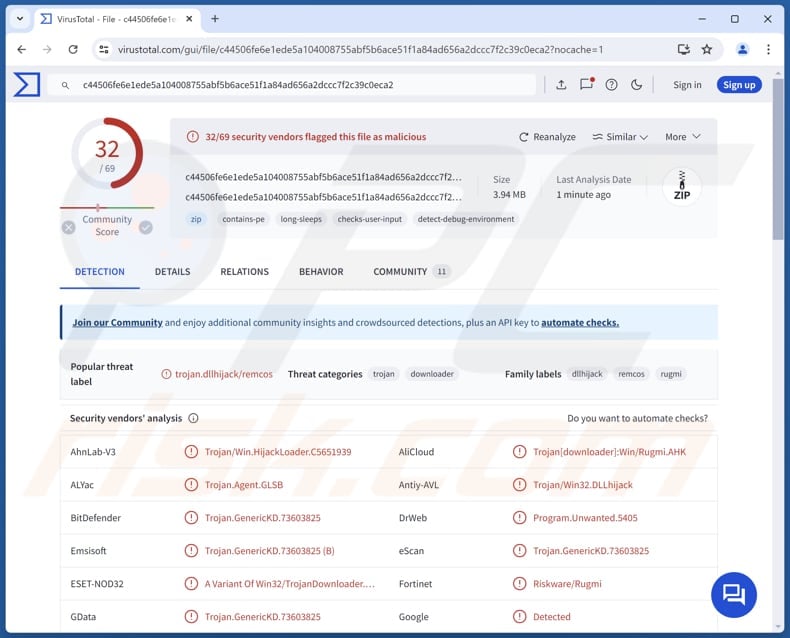
"CrowdStrike Scam" in detail
One of the known malware campaigns that exploited an error in CrowdStrike's update targeted BBVA bank (a Spanish multinational financial services company) customers. This campaign involved a fake CrowdStrike Hotfix update that installed the Remcos RAT. The fake update was promoted through a phishing page masquerading as a BBVA Intranet portal.
The file used in this campaign was a malicious archive file that contained instructions urging users to install the update to avoid network errors. A Remote Access Trojan (RAT) is a type of malware that allows an attacker to remotely control an infected computer. It enables access to the system, often providing capabilities such as keylogging, file transfers, and surveillance, which can be used for various malicious purposes.
Another campaign (distributed via email) involved a fake CrowdStrike update that contained a data wiper. Cybercriminals sent emails instructing recipients to download a ZIP file that contained a malicious executable file. A data wiper is a type of malware designed to permanently erase or corrupt data on a computer.
It is also known that scammers are exploiting CrowdStrike's error in the update to promote various scams. For instance, they promote the launch of the $CROWDSTRIKE, $CROWDSTROKE or other fake tokens to trick unsuspecting individuals into disclosing sensitive information or transferring cryptocurrency to scammers.
In other scams, they impersonate companies offering compensation for affected users to trick them into disclosing sensitive information, paying for fake services, or even providing them access to computers, which can lead to issues like computer infections, financial losses, data encryption, and negative consequences.
It is important to note that Microsoft has released a legitimate fix for the error in CrowdStrike's update. This fix can be downloaded here.
| Name | Fake CrowdStrike update error fixes |
| Threat Type | Phishing, Scam, Social Engineering, Fraud |
| Fake Claim | Affected users can obtain a fix for the error in CrowdStrik's update |
| Legitimate Fix | A fix provided by Microsoft |
| Distributed Malware | Remcos RAT, data wiper, and possibly other malware |
| Examples Of Campaign Domains | clownstrike[.]co, clownstrike[.]co.uk, crashstrike[.]com, crowdfalcon-immed-update[.]com, crowdstrike-bsod[.]com, crowdstrike-helpdesk[.]com, crowdstrike0day[.]com, crowdstrike[.]blue, crowdstrike[.]bot, crowdstrike[.]cam, crowdstrike[.]fail, crowdstrikebluescreen[.]com, crowdstrikebug[.]com, crowdstrikeclaim[.]com, crowdstrikeclaims[.]com, crowdstrikedoomsday[.]com, crowdstrikedown[.]com, crowdstrikefail[.]com, crowdstrikeglitch[.]com, crowdstrikeoopsie[.]com |
| Symptoms | Unofficial domains, fake error messages, fake system warnings, pop-up errors, |
| Distribution methods | Fake websites, email, social media |
| Damage | Loss of sensitive private information, monetary loss, identity theft, possible malware infections. |
| Malware Removal (Windows) |
To eliminate possible malware infections, scan your computer with legitimate antivirus software. Our security researchers recommend using Combo Cleaner. Download Combo CleanerTo use full-featured product, you have to purchase a license for Combo Cleaner. 7 days free trial available. Combo Cleaner is owned and operated by RCS LT, the parent company of PCRisk.com. |
Conclusion
In summary, a flaw in a CrowdStrike update led to system crashes, which cybercriminals exploited for various attacks. They used this opportunity to distribute malware, such as the Remcos RAT and data wipers, through phishing and fraudulent emails. Additionally, scammers promoted fake tokens and false compensation offers, underscoring the importance of vigilance against such malicious schemes.
How did I open a scam website?
Scammers targeting users affected by the CrowdStrike error use email and fake or compromised X (formerly Twitter) accounts, and similar channels to trick users into opening fake websites. It is also common for scams to be promoted via deceptive advertisements and notifications generated by untrustworthy websites.
Additionally, scams can be encountered through websites that employ rogue advertising networks (e.g., illegal movie streaming pages and torrent sites). In other cases, users may be lured into visiting scam pages via SMS and messaging apps, ads generated by installed adware, and online forums.
How to avoid visiting scam pages?
Always verify the legitimacy of links before clicking, especially in unsolicited emails or messages. Do not interact with pop-ups, buttons, links, and ads on suspicious websites. Download applications from reliable sources, such as official web pages or app stores. Avoid visiting web pages offering pirated software or illegal services.
Do not permit questionable websites to show notifications. Scan your computer regularly for unwanted apps (and other threats like malware). Keep the operating system and installed software up to date. If your computer is already infected with unwanted apps, we recommend running a scan with Combo Cleaner Antivirus for Windows to automatically eliminate them.
Fake CrowdStrike fix distributing Remcos RAT:
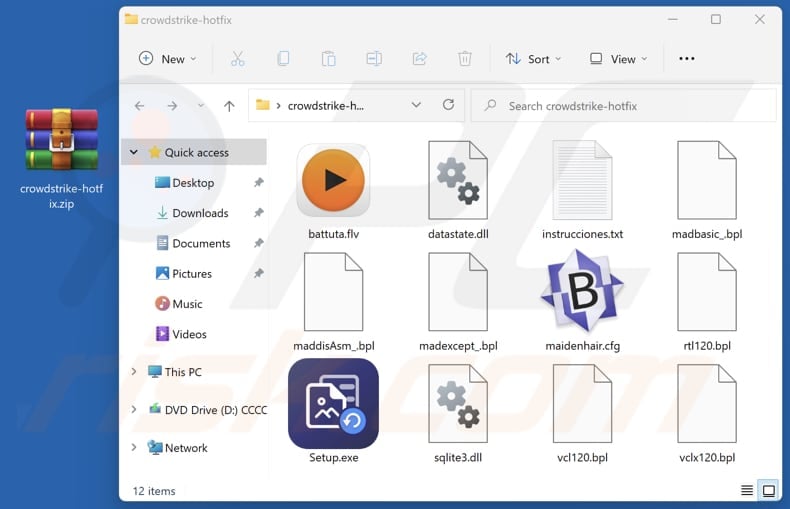
Screenshot of the email promoting a fake fix containing a data wiper:
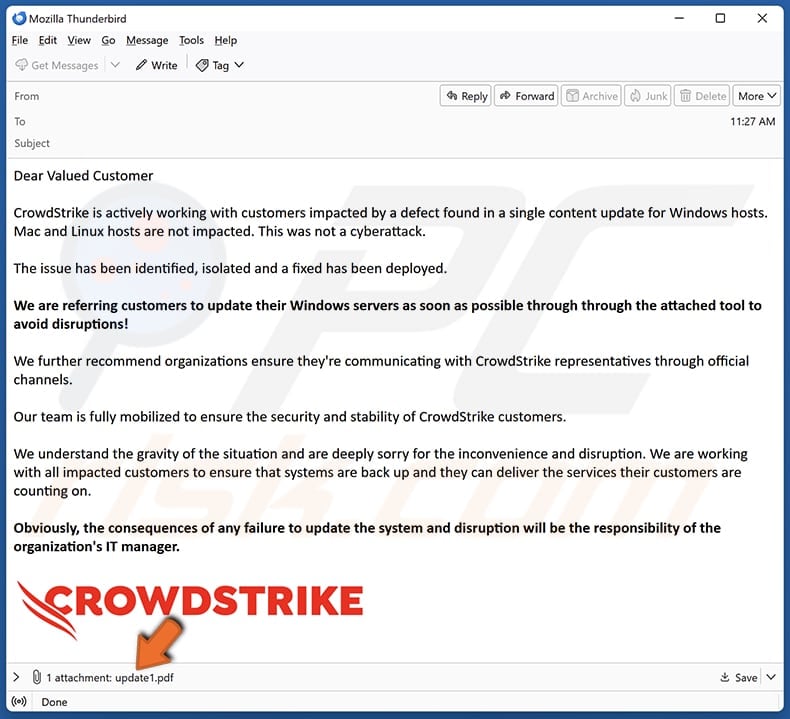
Text in this email:
Dear Valued Customer
CrowdStrike is actively working with customers impacted by a defect found in a single content update for Windows hosts. Mac and Linux hosts are not impacted. This was not a cyberattack.
The issue has been identified, isolated and a fixed has been deployed.
We are referring customers to update their Windows servers as soon as possible through through the attached tool to avoid disruptions!
We further recommend organizations ensure they're communicating with CrowdStrike representatives through official channels.
Our team is fully mobilized to ensure the security and stability of CrowdStrike customers.
We understand the gravity of the situation and are deeply sorry for the inconvenience and disruption. We are working with all impacted customers to ensure that systems are back up and they can deliver the services their customers are counting on.
Obviously, the consequences of any failure to update the system and disruption will be the responsibility of the organization's IT manager.
Screenshot of a malicious PDF attachment containing a download link for data wiper:

Tweet on X (Twitter) promoting the fake $CROWDSTRIKE token:
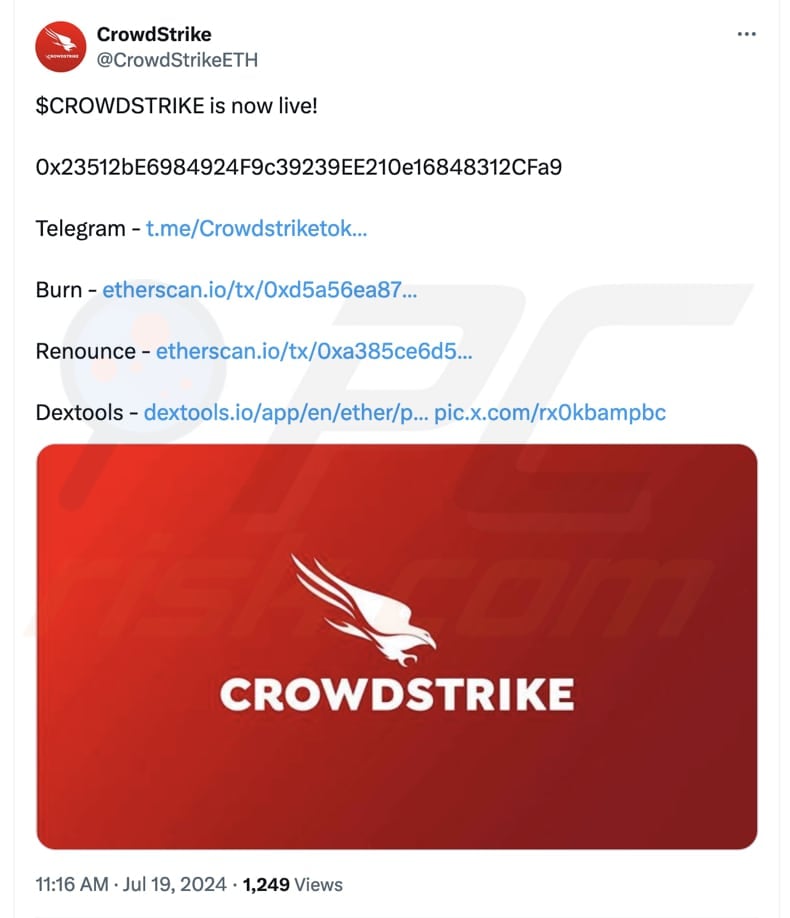
Deceptive website promoting the fake $CROWDSTRIKE token:
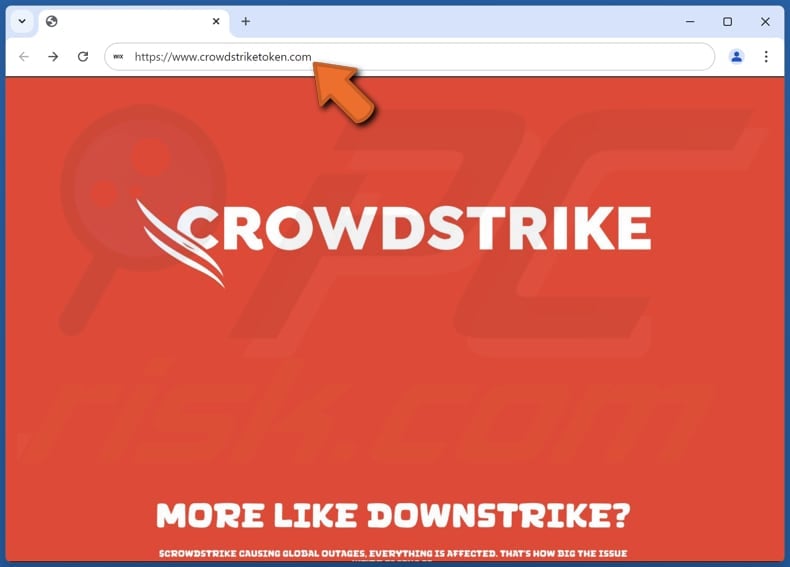
Another deceptive website promoting the fake $CROWDSTROKE token:

Scam website offering compensation for affected companies:

Fraudulent email containing a malicious attachment distributing Daolpu:
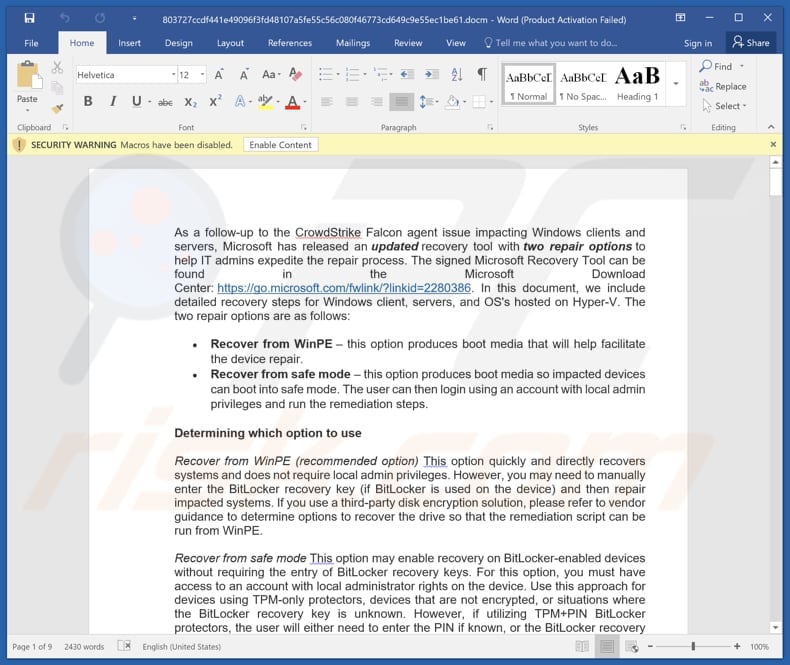
Instant automatic malware removal:
Manual threat removal might be a lengthy and complicated process that requires advanced IT skills. Combo Cleaner is a professional automatic malware removal tool that is recommended to get rid of malware. Download it by clicking the button below:
DOWNLOAD Combo CleanerBy downloading any software listed on this website you agree to our Privacy Policy and Terms of Use. To use full-featured product, you have to purchase a license for Combo Cleaner. 7 days free trial available. Combo Cleaner is owned and operated by RCS LT, the parent company of PCRisk.com.
Quick menu:
- What is Fake CrowdStrike update error fixes?
- How to identify a pop-up scam?
- How do pop-up scams work?
- How to remove fake pop-ups?
- How to prevent fake pop-ups?
- What to do if you fell for a pop-up scam?
How to identify a pop-up scam?
Pop-up windows with various fake messages are a common type of lures cybercriminals use. They collect sensitive personal data, trick Internet users into calling fake tech support numbers, subscribe to useless online services, invest in shady cryptocurrency schemes, etc.
While in the majority of cases these pop-ups don't infect users' devices with malware, they can cause direct monetary loss or could result in identity theft.
Cybercriminals strive to create their rogue pop-up windows to look trustworthy, however, scams typically have the following characteristics:
- Spelling mistakes and non-professional images - Closely inspect the information displayed in a pop-up. Spelling mistakes and unprofessional images could be a sign of a scam.
- Sense of urgency - Countdown timer with a couple of minutes on it, asking you to enter your personal information or subscribe to some online service.
- Statements that you won something - If you haven't participated in a lottery, online competition, etc., and you see a pop-up window stating that you won.
- Computer or mobile device scan - A pop-up window that scans your device and informs of detected issues - is undoubtedly a scam; webpages cannot perform such actions.
- Exclusivity - Pop-up windows stating that only you are given secret access to a financial scheme that can quickly make you rich.
Example of a pop-up scam:

How do pop-up scams work?
Cybercriminals and deceptive marketers usually use various advertising networks, search engine poisoning techniques, and shady websites to generate traffic to their pop-ups. Users land on their online lures after clicking on fake download buttons, using a torrent website, or simply clicking on an Internet search engine result.
Based on users' location and device information, they are presented with a scam pop-up. Lures presented in such pop-ups range from get-rich-quick schemes to fake virus scans.
How to remove fake pop-ups?
In most cases, pop-up scams do not infect users' devices with malware. If you encountered a scam pop-up, simply closing it should be enough. In some cases scam, pop-ups may be hard to close; in such cases - close your Internet browser and restart it.
In extremely rare cases, you might need to reset your Internet browser. For this, use our instructions explaining how to reset Internet browser settings.
How to prevent fake pop-ups?
To prevent seeing pop-up scams, you should visit only reputable websites. Torrent, Crack, free online movie streaming, YouTube video download, and other websites of similar reputation commonly redirect Internet users to pop-up scams.
To minimize the risk of encountering pop-up scams, you should keep your Internet browsers up-to-date and use reputable anti-malware application. For this purpose, we recommend Combo Cleaner Antivirus for Windows.
What to do if you fell for a pop-up scam?
This depends on the type of scam that you fell for. Most commonly, pop-up scams try to trick users into sending money, giving away personal information, or giving access to one's device.
- If you sent money to scammers: You should contact your financial institution and explain that you were scammed. If informed promptly, there's a chance to get your money back.
- If you gave away your personal information: You should change your passwords and enable two-factor authentication in all online services that you use. Visit Federal Trade Commission to report identity theft and get personalized recovery steps.
- If you let scammers connect to your device: You should scan your computer with reputable anti-malware (we recommend Combo Cleaner Antivirus for Windows) - cyber criminals could have planted trojans, keyloggers, and other malware, don't use your computer until removing possible threats.
- Help other Internet users: report Internet scams to Federal Trade Commission.
Frequently Asked Questions (FAQ)
What is a scam website or email?
It is a fraudulent email or page designed to trick individuals into taking certain actions. It is common for scam pages and emails to be disguised as legitimate/official.
What is the purpose of an online cam?
These scams can be used for various purposes. The most common ones include stealing sensitive information, extracting money, or distributing malicious software.
Why do I encounter scam websites?
Typically, users land on scam pages by clicking misleading links in fraudulent pages or deceptive advertisements. Notifications from shady sites, web pages associated with rogue advertising networks, and unwanted apps can also lead users to scam websites.
Will Combo Cleaner protect me from scam pages?
Combo Cleaner is designed to scan every website you visit, identifying and blocking malicious sites. It also detects websites that host scams, promptly warning you and restricting access to protect you.
Share:

Tomas Meskauskas
Expert security researcher, professional malware analyst
I am passionate about computer security and technology. I have an experience of over 10 years working in various companies related to computer technical issue solving and Internet security. I have been working as an author and editor for pcrisk.com since 2010. Follow me on Twitter and LinkedIn to stay informed about the latest online security threats.
PCrisk security portal is brought by a company RCS LT.
Joined forces of security researchers help educate computer users about the latest online security threats. More information about the company RCS LT.
Our malware removal guides are free. However, if you want to support us you can send us a donation.
DonatePCrisk security portal is brought by a company RCS LT.
Joined forces of security researchers help educate computer users about the latest online security threats. More information about the company RCS LT.
Our malware removal guides are free. However, if you want to support us you can send us a donation.
Donate
▼ Show Discussion